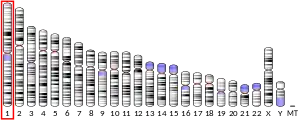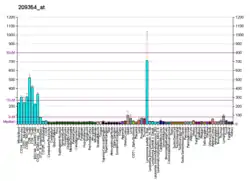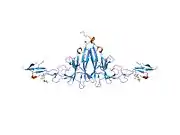Herpesvirus entry mediator
Herpesvirus entry mediator (HVEM), also known as tumor necrosis factor receptor superfamily member 14 (TNFRSF14), is a human cell surface receptor of the TNF-receptor superfamily.[5][6][7][8]
Nomenclature
This protein was originally known as herpesvirus entry mediator A (HveA); HveB and HveC are structurally unrelated proteins of the immunoglobulin superfamily. It is also known as CD270 in the cluster of differentiation classification. Moreover, it is also referred to as ATAR (another TRAF-associated receptor).
Function
The protein encoded by this gene is a member of the TNF-receptor superfamily. The cytoplasmic region of this receptor was found to bind to several TNF receptor associated factor (TRAF) family members, which may mediate the signal transduction pathways that activate the immune response.[7]
In melanocytic cells TNFRSF14 gene expression may be regulated by MITF.[9]
Interactions
TNFRSF14 has been shown to interact with TRAF2,[10][11] TNFSF14[12][13] and TRAF5.[10][11]
Clinical relevance
Mutations in this gene have been recurrently been associated to cases of diffuse large B-cell lymphoma[14][15] and pediatric-type follicular lymphoma.[16]
This receptor was identified as a cellular mediator of herpes simplex virus (HSV) entry. Binding of HSV viral envelope glycoprotein D (gD) to this receptor protein has been shown to be part of the viral entry mechanism.[7]
References
- ENSG00000157873 GRCh38: Ensembl release 89: ENSG00000273936, ENSG00000157873 - Ensembl, May 2017
- GRCm38: Ensembl release 89: ENSMUSG00000042333 - Ensembl, May 2017
- "Human PubMed Reference:". National Center for Biotechnology Information, U.S. National Library of Medicine.
- "Mouse PubMed Reference:". National Center for Biotechnology Information, U.S. National Library of Medicine.
- Montgomery RI, Warner MS, Lum BJ, Spear PG (November 1996). "Herpes simplex virus-1 entry into cells mediated by a novel member of the TNF/NGF receptor family". Cell. 87 (3): 427–36. doi:10.1016/S0092-8674(00)81363-X. PMID 8898196.
- Kwon BS, Tan KB, Ni J, Oh KO, Lee ZH, Kim KK, Kim YJ, Wang S, Gentz R, Yu GL, Harrop J, Lyn SD, Silverman C, Porter TG, Truneh A, Young PR (May 1997). "A newly identified member of the tumor necrosis factor receptor superfamily with a wide tissue distribution and involvement in lymphocyte activation". The Journal of Biological Chemistry. 272 (22): 14272–6. doi:10.1074/jbc.272.22.14272. PMID 9162061.
- "Entrez Gene: TNFRSF14 tumor necrosis factor receptor superfamily, member 14 (herpesvirus entry mediator)".
- Ware, Carl (2008). "Chapter 25: TNF-Related Cytokines in Immunity". In Paul, William (ed.). Fundamental Immunology (Book) (6th ed.). Philadelphia: Lippincott Williams & Wilkins. pp. 776–801. ISBN 978-0-7817-6519-0.
- Hoek KS, Schlegel NC, Eichhoff OM, Widmer DS, Praetorius C, Einarsson SO, Valgeirsdottir S, Bergsteinsdottir K, Schepsky A, Dummer R, Steingrimsson E (December 2008). "Novel MITF targets identified using a two-step DNA microarray strategy". Pigment Cell & Melanoma Research. 21 (6): 665–76. doi:10.1111/j.1755-148X.2008.00505.x. PMID 19067971.
- Hsu H, Solovyev I, Colombero A, Elliott R, Kelley M, Boyle WJ (May 1997). "ATAR, a novel tumor necrosis factor receptor family member, signals through TRAF2 and TRAF5". The Journal of Biological Chemistry. 272 (21): 13471–4. doi:10.1074/jbc.272.21.13471. PMID 9153189.
- Marsters SA, Ayres TM, Skubatch M, Gray CL, Rothe M, Ashkenazi A (May 1997). "Herpesvirus entry mediator, a member of the tumor necrosis factor receptor (TNFR) family, interacts with members of the TNFR-associated factor family and activates the transcription factors NF-kappaB and AP-1". The Journal of Biological Chemistry. 272 (22): 14029–32. doi:10.1074/jbc.272.22.14029. PMID 9162022.
- Zhang J, Salcedo TW, Wan X, Ullrich S, Hu B, Gregorio T, Feng P, Qi S, Chen H, Cho YH, Li Y, Moore PA, Wu J (June 2001). "Modulation of T-cell responses to alloantigens by TR6/DcR3". The Journal of Clinical Investigation. 107 (11): 1459–68. doi:10.1172/JCI12159. PMC 209323. PMID 11390428.
- Yu KY, Kwon B, Ni J, Zhai Y, Ebner R, Kwon BS (May 1999). "A newly identified member of tumor necrosis factor receptor superfamily (TR6) suppresses LIGHT-mediated apoptosis". The Journal of Biological Chemistry. 274 (20): 13733–6. doi:10.1074/jbc.274.20.13733. PMID 10318773.
- Morin RD, Mendez-Lago M, Mungall AJ, Goya R, Mungall KL, Corbett RD, Johnson NA, Severson TM, Chiu R, Field M, Jackman S, Krzywinski M, Scott DW, Trinh DL, Tamura-Wells J, Li S, Firme MR, Rogic S, Griffith M, Chan S, Yakovenko O, Meyer IM, Zhao EY, Smailus D, Moksa M, Chittaranjan S, Rimsza L, Brooks-Wilson A, Spinelli JJ, Ben-Neriah S, Meissner B, Woolcock B, Boyle M, McDonald H, Tam A, Zhao Y, Delaney A, Zeng T, Tse K, Butterfield Y, Birol I, Holt R, Schein J, Horsman DE, Moore R, Jones SJ, Connors JM, Hirst M, Gascoyne RD, Marra MA (August 2011). "Frequent mutation of histone-modifying genes in non-Hodgkin lymphoma". Nature. 476 (7360): 298–303. Bibcode:2011Natur.476..298M. doi:10.1038/nature10351. PMC 3210554. PMID 21796119.
- Lohr JG, Stojanov P, Lawrence MS, Auclair D, Chapuy B, Sougnez C, Cruz-Gordillo P, Knoechel B, Asmann YW, Slager SL, Novak AJ, Dogan A, Ansell SM, Link BK, Zou L, Gould J, Saksena G, Stransky N, Rangel-Escareño C, Fernandez-Lopez JC, Hidalgo-Miranda A, Melendez-Zajgla J, Hernández-Lemus E, Schwarz-Cruz y Celis A, Imaz-Rosshandler I, Ojesina AI, Jung J, Pedamallu CS, Lander ES, Habermann TM, Cerhan JR, Shipp MA, Getz G, Golub TR (March 2012). "Discovery and prioritization of somatic mutations in diffuse large B-cell lymphoma (DLBCL) by whole-exome sequencing". Proceedings of the National Academy of Sciences of the United States of America. 109 (10): 3879–84. Bibcode:2012PNAS..109.3879L. doi:10.1073/pnas.1121343109. PMC 3309757. PMID 22343534.
- Koo M, Ohgami RS (May 2017). "Pediatric-type Follicular Lymphoma and Pediatric Nodal Marginal Zone Lymphoma: Recent Clinical, Morphologic, Immunophenotypic, and Genetic Insights". Advances in Anatomic Pathology. 24 (3): 128–135. doi:10.1097/PAP.0000000000000144. PMID 28277421.
Further reading
- Hsu H, Solovyev I, Colombero A, Elliott R, Kelley M, Boyle WJ (May 1997). "ATAR, a novel tumor necrosis factor receptor family member, signals through TRAF2 and TRAF5". The Journal of Biological Chemistry. 272 (21): 13471–4. doi:10.1074/jbc.272.21.13471. PMID 9153189.
- Marsters SA, Ayres TM, Skubatch M, Gray CL, Rothe M, Ashkenazi A (May 1997). "Herpesvirus entry mediator, a member of the tumor necrosis factor receptor (TNFR) family, interacts with members of the TNFR-associated factor family and activates the transcription factors NF-kappaB and AP-1". The Journal of Biological Chemistry. 272 (22): 14029–32. doi:10.1074/jbc.272.22.14029. PMID 9162022.
- Mauri DN, Ebner R, Montgomery RI, Kochel KD, Cheung TC, Yu GL, Ruben S, Murphy M, Eisenberg RJ, Cohen GH, Spear PG, Ware CF (January 1998). "LIGHT, a new member of the TNF superfamily, and lymphotoxin alpha are ligands for herpesvirus entry mediator". Immunity. 8 (1): 21–30. doi:10.1016/S1074-7613(00)80455-0. PMID 9462508.
- Lee CH, Chinpaisal C, Wei LN (November 1998). "Cloning and characterization of mouse RIP140, a corepressor for nuclear orphan receptor TR2". Molecular and Cellular Biology. 18 (11): 6745–55. doi:10.1128/mcb.18.11.6745. PMC 109258. PMID 9774688.
- Kelly K, Manos E, Jensen G, Nadauld L, Jones DA (February 2000). "APRIL/TRDL-1, a tumor necrosis factor-like ligand, stimulates cell death". Cancer Research. 60 (4): 1021–7. PMID 10706119.
- Zhang J, Salcedo TW, Wan X, Ullrich S, Hu B, Gregorio T, Feng P, Qi S, Chen H, Cho YH, Li Y, Moore PA, Wu J (June 2001). "Modulation of T-cell responses to alloantigens by TR6/DcR3". The Journal of Clinical Investigation. 107 (11): 1459–68. doi:10.1172/JCI12159. PMC 209323. PMID 11390428.
- Franco PJ, Farooqui M, Seto E, Wei LN (August 2001). "The orphan nuclear receptor TR2 interacts directly with both class I and class II histone deacetylases". Molecular Endocrinology. 15 (8): 1318–28. doi:10.1210/mend.15.8.0682. PMID 11463856.
- Carfí A, Willis SH, Whitbeck JC, Krummenacher C, Cohen GH, Eisenberg RJ, Wiley DC (July 2001). "Herpes simplex virus glycoprotein D bound to the human receptor HveA". Molecular Cell. 8 (1): 169–79. doi:10.1016/S1097-2765(01)00298-2. PMID 11511370.
- Bobik A, Kalinina N (December 2001). "Tumor necrosis factor receptor and ligand superfamily family members TNFRSF14 and LIGHT: new players in human atherogenesis". Arteriosclerosis, Thrombosis, and Vascular Biology. 21 (12): 1873–5. doi:10.1161/atvb.21.12.1873. PMID 11742858.
- Struyf F, Posavad CM, Keyaerts E, Van Ranst M, Corey L, Spear PG (January 2002). "Search for polymorphisms in the genes for herpesvirus entry mediator, nectin-1, and nectin-2 in immune seronegative individuals". The Journal of Infectious Diseases. 185 (1): 36–44. doi:10.1086/338116. PMID 11756979.
- Carfí A, Gong H, Lou H, Willis SH, Cohen GH, Eisenberg RJ, Wiley DC (May 2002). "Crystallization and preliminary diffraction studies of the ectodomain of the envelope glycoprotein D from herpes simplex virus 1 alone and in complex with the ectodomain of the human receptor HveA". Acta Crystallographica Section D. 58 (Pt 5): 836–8. doi:10.1107/S0907444902001270. PMID 11976496.
- Hu YC, Shyr CR, Che W, Mu XM, Kim E, Chang C (September 2002). "Suppression of estrogen receptor-mediated transcription and cell growth by interaction with TR2 orphan receptor". The Journal of Biological Chemistry. 277 (37): 33571–9. doi:10.1074/jbc.M203531200. PMID 12093804.
- Gill RM, Ni J, Hunt JS (December 2002). "Differential expression of LIGHT and its receptors in human placental villi and amniochorion membranes". The American Journal of Pathology. 161 (6): 2011–7. doi:10.1016/S0002-9440(10)64479-3. PMC 1850908. PMID 12466117.
- Bender FC, Whitbeck JC, Ponce de Leon M, Lou H, Eisenberg RJ, Cohen GH (September 2003). "Specific association of glycoprotein B with lipid rafts during herpes simplex virus entry". Journal of Virology. 77 (17): 9542–52. doi:10.1128/JVI.77.17.9542-9552.2003. PMC 187402. PMID 12915568.
- Jung HW, La SJ, Kim JY, Heo SK, Kim JY, Wang S, Kim KK, Lee KM, Cho HR, Lee HW, Kwon B, Kim BS, Kwon BS (December 2003). "High levels of soluble herpes virus entry mediator in sera of patients with allergic and autoimmune diseases". Experimental & Molecular Medicine. 35 (6): 501–8. doi:10.1038/emm.2003.65. PMID 14749527.
- Krummenacher C, Baribaud F, Ponce de Leon M, Baribaud I, Whitbeck JC, Xu R, Cohen GH, Eisenberg RJ (May 2004). "Comparative usage of herpesvirus entry mediator A and nectin-1 by laboratory strains and clinical isolates of herpes simplex virus". Virology. 322 (2): 286–99. doi:10.1016/j.virol.2004.02.005. PMID 15110526.
This article incorporates text from the United States National Library of Medicine, which is in the public domain.







